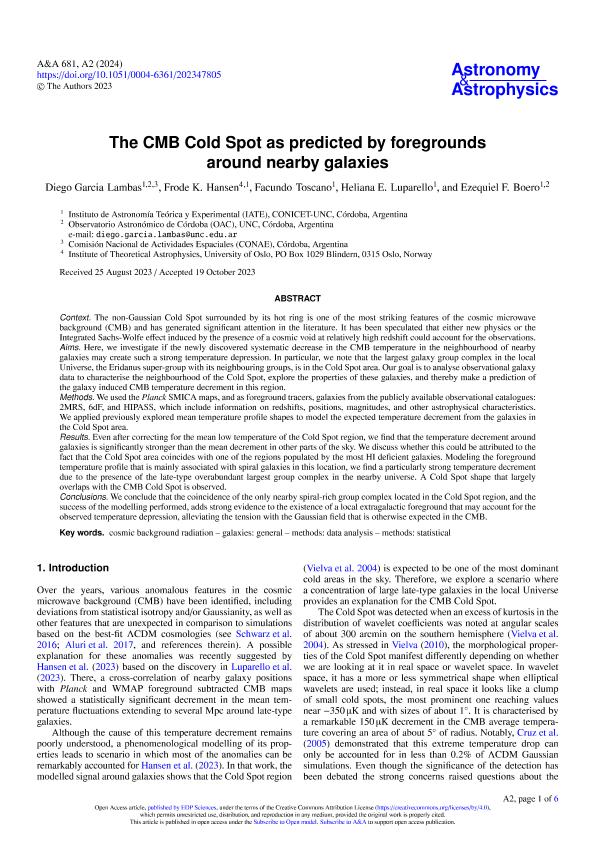Mostrar el registro sencillo del ítem
dc.contributor.author
Garcia Lambas, Diego Rodolfo

dc.contributor.author
Hansen, Frode K.
dc.contributor.author
Toscano, Facundo Nicolás

dc.contributor.author
Luparello, Heliana Estefanía

dc.contributor.author
Boero, Ezequiel Fernando

dc.date.available
2024-02-07T15:30:31Z
dc.date.issued
2023-12
dc.identifier.citation
Garcia Lambas, Diego Rodolfo; Hansen, Frode K.; Toscano, Facundo Nicolás; Luparello, Heliana Estefanía; Boero, Ezequiel Fernando; The CMB Cold Spot as predicted by foregrounds around nearby galaxies; EDP Sciences; Astronomy and Astrophysics; 681; 12-2023; 1-6
dc.identifier.issn
0004-6361
dc.identifier.uri
http://hdl.handle.net/11336/226186
dc.description.abstract
Context. The non-Gaussian Cold Spot surrounded by its hot ring is one of the most striking features of the cosmic microwave background (CMB) and has generated significant attention in the literature. It has been speculated that either new physics or the Integrated Sachs-Wolfe effect induced by the presence of a cosmic void at relatively high redshift could account for the observations. Aims. Here, we investigate if the newly discovered systematic decrease in the CMB temperature in the neighbourhood of nearby galaxies may create such a strong temperature depression. In particular, we note that the largest galaxy group complex in the local Universe, the Eridanus super-group with its neighbouring groups, is in the Cold Spot area. Our goal is to analyse observational galaxy data to characterise the neighbourhood of the Cold Spot, explore the properties of these galaxies, and thereby make a prediction of the galaxy induced CMB temperature decrement in this region. Methods. We used the Planck SMICA maps, and as foreground tracers, galaxies from the publicly available observational catalogues: 2MRS, 6dF, and HIPASS, which include information on redshifts, positions, magnitudes, and other astrophysical characteristics. We applied previously explored mean temperature profile shapes to model the expected temperature decrement from the galaxies in the Cold Spot area. Results. Even after correcting for the mean low temperature of the Cold Spot region, we find that the temperature decrement around galaxies is significantly stronger than the mean decrement in other parts of the sky. We discuss whether this could be attributed to the fact that the Cold Spot area coincides with one of the regions populated by the most HI deficient galaxies. Modeling the foreground temperature profile that is mainly associated with spiral galaxies in this location, we find a particularly strong temperature decrement due to the presence of the late-type overabundant largest group complex in the nearby universe. A Cold Spot shape that largely overlaps with the CMB Cold Spot is observed. Conclusions. We conclude that the coincidence of the only nearby spiral-rich group complex located in the Cold Spot region, and the success of the modelling performed, adds strong evidence to the existence of a local extragalactic foreground that may account for the observed temperature depression, alleviating the tension with the Gaussian field that is otherwise expected in the CMB.
dc.format
application/pdf
dc.language.iso
eng
dc.publisher
EDP Sciences

dc.rights
info:eu-repo/semantics/openAccess
dc.rights.uri
https://creativecommons.org/licenses/by/2.5/ar/
dc.subject
COSMIC BACKGROUND RADIATION
dc.subject
GALAXIES: GENERAL
dc.subject
METHODS: DATA ANALYSIS
dc.subject
METHODS: STATISTICAL
dc.subject.classification
Astronomía

dc.subject.classification
Ciencias Físicas

dc.subject.classification
CIENCIAS NATURALES Y EXACTAS

dc.title
The CMB Cold Spot as predicted by foregrounds around nearby galaxies
dc.type
info:eu-repo/semantics/article
dc.type
info:ar-repo/semantics/artículo
dc.type
info:eu-repo/semantics/publishedVersion
dc.date.updated
2024-02-06T13:04:44Z
dc.journal.volume
681
dc.journal.pagination
1-6
dc.journal.pais
Francia

dc.journal.ciudad
Paris
dc.description.fil
Fil: Garcia Lambas, Diego Rodolfo. Consejo Nacional de Investigaciones Científicas y Técnicas. Centro Científico Tecnológico Conicet - Córdoba. Instituto de Astronomía Teórica y Experimental. Universidad Nacional de Córdoba. Observatorio Astronómico de Córdoba. Instituto de Astronomía Teórica y Experimental; Argentina. Comision Nacional de Actividades Espaciales; Argentina
dc.description.fil
Fil: Hansen, Frode K.. University of Oslo; Noruega
dc.description.fil
Fil: Toscano, Facundo Nicolás. Consejo Nacional de Investigaciones Científicas y Técnicas. Centro Científico Tecnológico Conicet - Córdoba. Instituto de Astronomía Teórica y Experimental. Universidad Nacional de Córdoba. Observatorio Astronómico de Córdoba. Instituto de Astronomía Teórica y Experimental; Argentina
dc.description.fil
Fil: Luparello, Heliana Estefanía. Consejo Nacional de Investigaciones Científicas y Técnicas. Centro Científico Tecnológico Conicet - Córdoba. Instituto de Astronomía Teórica y Experimental. Universidad Nacional de Córdoba. Observatorio Astronómico de Córdoba. Instituto de Astronomía Teórica y Experimental; Argentina
dc.description.fil
Fil: Boero, Ezequiel Fernando. Consejo Nacional de Investigaciones Científicas y Técnicas. Centro Científico Tecnológico Conicet - Córdoba. Instituto de Astronomía Teórica y Experimental. Universidad Nacional de Córdoba. Observatorio Astronómico de Córdoba. Instituto de Astronomía Teórica y Experimental; Argentina
dc.journal.title
Astronomy and Astrophysics

dc.relation.alternativeid
info:eu-repo/semantics/altIdentifier/url/https://www.aanda.org/10.1051/0004-6361/202347805
dc.relation.alternativeid
info:eu-repo/semantics/altIdentifier/doi/http://dx.doi.org/10.1051/0004-6361/202347805
Archivos asociados
